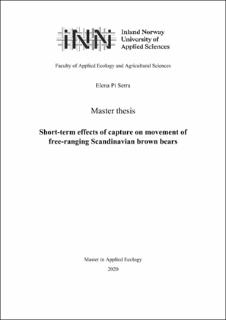Short-term effects of capture on movement of free-ranging Scandinavian brown bears
Master thesis
Permanent lenke
https://hdl.handle.net/11250/2660560Utgivelsesdato
2020Metadata
Vis full innførselSamlinger
Sammendrag
Research of free-ranging wildlife often involves capture and chemical immobilization of animals. Such an invasive and stressful procedure may cause alterations in the animals’ physiology and behavior. Thus, evaluating the effects of capture and handling can improve our understanding on the impact that these cause on both the welfare of wildlife and the quality of collected data. This study aimed to evaluate the effects of capture on movement of Scandinavian brown bears (Ursus arctos). I used generalized additive mixed effect models to examine movement rates of 55 GPS-collared individuals during 91 capture events immediately after the capture and during the following 10 days. Most apparent effects were short-term, with individuals experiencing low movement rates the hours after the capture and returning to a stable movement rate 4 days after the capture. Moreover, the movement patterns of the 24 family groups differed from solitary bears. Family members showed higher movement rates immediately after capture followed by two periods of depression on the movement rates around 48 and 120 hours after capture. Additionally, higher movement rates were observed when ambient temperature was between 0 – 10 ºC and dropped as ambient temperatures increased. Bears travelled longer distances per hour during light and twilight conditions than during the night. Further research is warranted to investigate the effect of additional variables on the post-capture movement patterns of the brown bear. However, based on the results of my study I suggest that data from at least the 4 following days after a capture event should be excluded when analyzing data from brown bears.
